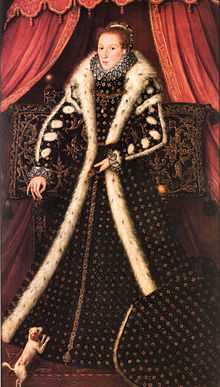Zibellino

A zibellino, flea-fur or fur tippet is a women's fashion accessory popular in the later 15th and 16th centuries. A zibellino, from the Italian word for "sable", is the pelt of a sable or marten worn draped at the neck or hanging at the waist, or carried in the hand. The plural is zibellini. Some zibellini were fitted with faces and paws of goldsmith's work with jeweled eyes and pearl earrings, while unadorned furs were also fashionable.[1][2][3]
History


The earliest surviving mention of a marten pelt to be worn as neck ornament occurs in an inventory of Charles the Bold, Duke of Burgundy, dated 1467, but the fashion was widespread in Northern Italy by the 1490s.[2] Eleonora de Toledo owned at least four; the weasel was an early modern talisman for fertility and Leonora was applauded as La Fecondissima, "most fertile" for the number of her children.[4] Eleonora's daughter Isabella de' Medici appears with a zibellino in a portrait by a member of Bronzino's studio painted at the time of her marriage in 1558 to Paolo Giordano Orsini.[5]
The style spread slowly to the north and west. Mary, Queen of Scots, brought fur pieces on her return to Scotland from France in 1561; one of her zibellini had a head of jet.[2] Elizabeth I of England received a "Sable Skynne the hed and fourre featte of gold fully furnyshed with Dyamondes and Rubyes" as a New Year's Gift from the Earl of Leicester in 1585.[6]
The traditional costume historian's term for this accessory, flea-fur, is from the German Flohpelz, coined by Wendelin Boeheim in 1894, who was the first to suggest that the furs were intended to attract fleas away from the body of the wearer.[2] There is no historical evidence to support this unlikely claim. Italians simply called these accessories "zibellini", their word for sables, and speakers of other languages called them "martens", "sables" or "ermines" in their native tongues.[2]
The fashion for carrying zibellini died out in the first years of the 17th century, although fox, mink and other pelts were worn in similar fashion in the 19th and 20th century.[7]
Gallery
-

Italy, 1515
-

Italy 1557
-

Isabella de' Medici, Italy, 1558
-

France, mid-16th century
-

probably England, mid-16th century
-

England, ca. 1570-75
-

Elisabeth of Valois, Spain, 1560s
See also
Notes
- ↑ Payne, Blanche: History of Costume from the Ancient Egyptians to the Twentieth Century, Harper & Row, 1965, p. 294, 321
- ↑ 2.0 2.1 2.2 2.3 2.4 Sherrill, Tawny: "Fleas, Furs, and Fashions: Zibellini as Luxury Accessories of the Renaissance", in Robin Netherton and Gale R. Owen-Crocker, editors, Medieval Clothing and Textiles, Volume 2, p. 121-150
- ↑ Scarisbrick, Diana, Tudor and Jacobean Jewellery, p. 99-100
- ↑ Talisman: Jacqueline Marie Musacchio, "Weasels and pregnancy in Renaissance Italy", Renaissance Studies 15.2 (June 2001:172-87); Fecondissima: Caroline P. Murphy, Murder of a Medici Princes 2008:69ff
- ↑ Caroline P. Murphy, Murder of a Medici Princess 2008:69ff (illustrated).
- ↑ Arnold, Janet: Queen Elizabeth's Wardrobe Unlock'd, p. 327
- ↑ Hawes, Elizabeth, Fashion is Spinach, New York, Random House, 1938
References
- Arnold, Janet, Queen Elizabeth's Wardrobe Unlock'd, W S Maney and Son Ltd, Leeds 1988. ISBN 0-901286-20-6
- Hawes, Elizabeth, Fashion is Spinach, New York, Random House, 1938
- Netherton, Robin, and Gale R. Owen-Crocker, editors, Medieval Clothing and Textiles, Volume 2, Woodbridge, Suffolk, UK, and Rochester, NY, the Boydell Press, 2006, ISBN 1-84383-203-8
- Payne, Blanche, History of Costume from the Ancient Egyptians to the Twentieth Century, Harper & Row, 1965. No ISBN for this edition; ASIN B0006BMNFS
- Scarisbrick, Diana, Tudor and Jacobean Jewellery, London, Tate Publishing, 1995, ISBN 1-85437-158-4
External links
| Wikimedia Commons has media related to Zibellini. |